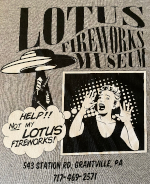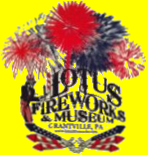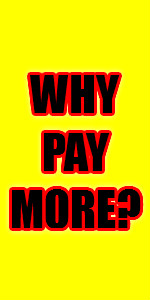
LOTUS FIREWORKS CO. & MUSEUM
I-81 HERSHEY-GRANTVILLE
EXIT 80
543 STATION ROAD
GRANTVILLE, PA 17028
info@lotusfireworks.com
717-469-2571
EVERYONE IS ENCOURAGED TO READ THE TERMS OF SALE PAGE BEFORE MAKING ANY PURCHASES.


"Be
the first in your neighborhood to sport one of Lotus's unique T's,
which was designed by one of our very own family member - Camille Hurt;
Graphic Designer Extraordinaire!"

SHOW YOUR LOVE FOR FIREWORKS WITH THESE GREAT LOTUS FIREWORKS CO. TEES!

| FIREWORKS TRIVIA
Common
Class C fireworks are usually manufactured to have a high ignition
point. The CPSC regularly tests Class C items for public use at
temperatures up to 169ºF for 48 hours. Fireworks which do not meet
federal regulations are returned or destroyed at the importer's
expense. U.S. manufactured fireworks have to meet very rigid test
requirements and therefore cost more to produce. Failure rate is
reported to be lower than some imports. A good point to remember is
that since most fireworks are handmade, caution should be used with
every item to be displayed.
Yes,
sparklers can be dangerous when used improperly. It was reported a few
years ago that a common sparkler was held too close to a child's dress
and within a few seconds she was in flames. The child suffered from
some serious burns.
Contrary
to some people's belief, fireworks should not be used by minors under
any circumstance. Quote from an "1885" fireworks catalog!
They
say that the two most dangerous months for setting off fireworks in the
northeast U.S. are November and March -- due to yearly ground and
weather conditions.
Tests have shown that moisture or dampness renders most fireworks more uncertain and dangerous or altogether useless.
Common
Class C fireworks, which are manufactured for public use are banned in
certain parts of the U.S. Approximately 38 states legalized some forms
of fireworks. Each state is different with regard to laws regulating
the sale, use, and storage of fireworks - especially Class B exhibition
grade fireworks. In some states, the local authorities decide if they
want their citizens to possess and use Class C fireworks. All major
cities across the U.S. forbid the use of any kind of fireworks devices
except as prescribed by law. If a fireworks device is offered for sale
and has no label or instructions don't buy it or set it off!
Cherry
Bombs, Ash Cans, Quarter Sticks, Half Sticks, etc., have been outlawed
in the U.S. since the mid-60s. A legitimate fireworks company does not
consider these devices fireworks nor should they promote them in any
way.
Practically
all fireworks manufacturing explosions in the U.S. and abroad are the
result of illegal and unlicensed manufacturers of low explosive devices
such as M-80s, Quarter sticks, etc.
During
WWII, the first bomb dropped on Tokyo, Japan was made by a fireworks
company in the U.S. At the time of national need, most fireworks
companies changed to war time production as was the case in WWI and the
Civil War.
In the early 30s the American Rocket Society used spent sky rocket bodies in their early rocket experiments.
One
of the earliest fireworks companies in the U.S. was the Rochester
Fireworks Company established in 1836. Unexcelled Company was
established in 1876. Both were located in New York.
At
present there is a group of American fireworks experts studying the
feasibility of making and firing a 75" shell. Largest one constructed
to date was 52" in diameter, and fired by a Japanese company over Mount
Fuji.
Most
professional display companies use 3" to 6" shells in their display. If
room and safety conditions permit 8" to 16" shells may be employed. 24"
fancy shells occasionally have been used for special occasions costing
about $3,500 a shot.
Some
of the most famous fireworks display companies in the U.S. are Grucci
of Long Island, NY, Austin Fireworks of Kansas, Southern International
in Alabama, and Ruggieri of France established 1734 (Washington D.C.
office) |
|





